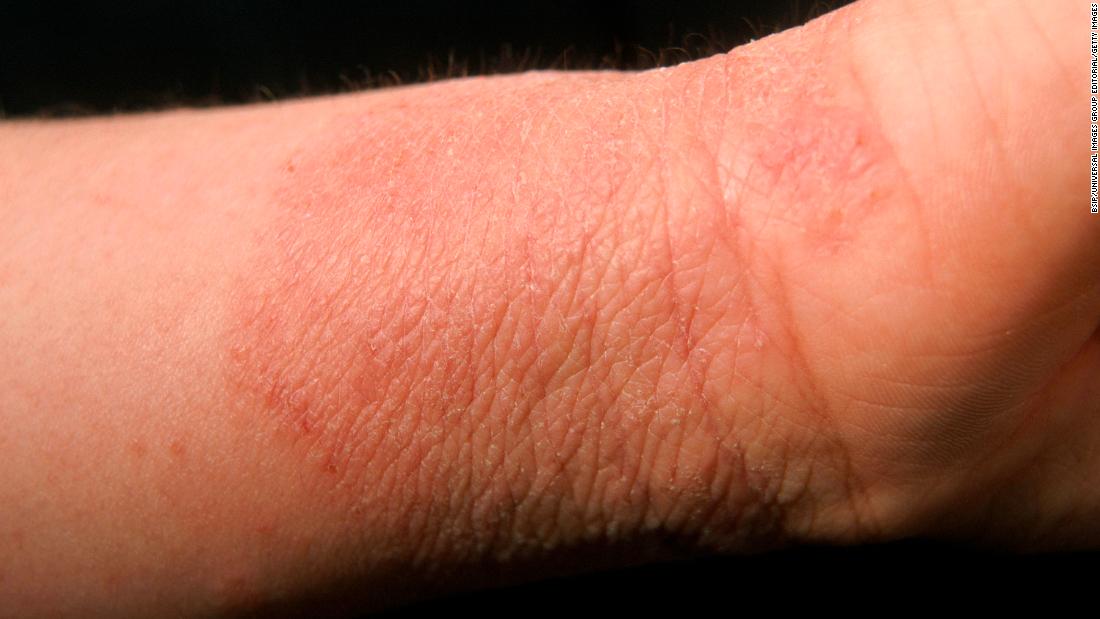 Eczema is the most common form of chronic dermatitis, a non-infectious skin condition characterized by an itchy rash. Commonly, across the literature, it is referred to as atopic dermatitis (AD) as well. Typically, it affects children and the situation gets better as time goes by, but adults can suffer from it as well. However, when it comes to the causes, there is no straightforward answer to explain these. By what we know about it so far, the most accurate answer would be – it is caused by a combination of genetic and environmental factors (basically, this means it is caused by something that’s written in the patient’s genetic code and something in his or her environment). However, giving that this answer can hardly satisfy the curiosity of people interested in the condition, we will discuss it in more detail and provide a broader perspective on the perplexity of eczema origin.
Eczema is the most common form of chronic dermatitis, a non-infectious skin condition characterized by an itchy rash. Commonly, across the literature, it is referred to as atopic dermatitis (AD) as well. Typically, it affects children and the situation gets better as time goes by, but adults can suffer from it as well. However, when it comes to the causes, there is no straightforward answer to explain these. By what we know about it so far, the most accurate answer would be – it is caused by a combination of genetic and environmental factors (basically, this means it is caused by something that’s written in the patient’s genetic code and something in his or her environment). However, giving that this answer can hardly satisfy the curiosity of people interested in the condition, we will discuss it in more detail and provide a broader perspective on the perplexity of eczema origin.
The roots are deep within the DNA 13
Although the pathophysiological mechanisms that cause eczema are pretty well described, their exact background remains to be a subject for academic debate. There are two widely accepted hypotheses – the first one concerns the imbalance in the immune system, and the second one concerns a defect in the skin barrier. The definitive answer to why eczema happens is still not found, but the two hypotheses offer a reasonable explanation. Also, they shouldn’t be taken as mutually exclusive but rather as points of view that complement each other.
The imbalance in the immune system hypothesis
The theory argues that the eczema results from an imbalance in the T cells production – in particular, in people with eczema, there are more T-helper 1 and T-regulatory cells (subtypes of T cells) than there should be. As a result, the amount of interleukins (substances that promote inflammatory response) is increased, so is the intensity of inflammation in the affected areas of the body.
The skin barrier hypotheses
The theory is a newer one and argues that individuals with mutations in the filaggrin gene more often develop eczema than those without the mutation. The filaggrin (filament aggregating protein) binds cells in the upper layer of the skin (referred to as epidermis) together and seals the tiny cracks between them. Filaggrin minimizes the water loss through the skin and penetration of the allergens from the environment (the size of the allergens varies – from small inorganic to large organic molecules or even microorganisms). In some people with the mutation, the production of filaggrin drops critically low, so the skin barrier doesn’t function as it should. The skin becomes more permeable for water (increased water loss), allergens and microorganisms.
The toll on health goes beyond the skin surface
Let’s take a pause from eczema causes here and briefly discuss the phenomenon known as “The Atopic March.” Our immune system works as a whole – defects in the execution of its functions reflect themselves on the whole body more often than not. Eczema is a skin condition, but the same genetic factors that lie in its background also affect other regions of the body. “The Atopic March” describes a temporal sequence of conditions that develop on the terrain of inadequate immune response seen in patients with eczema. The flaw mentioned above in the T-helper
lymphocyte function also can cause food allergies, asthma or allergic rhinitis. The eczema kicks in first and, in the early years of life, is often followed by the rest of the atopic cascade. The importance of this phenomenon lies in the fact that a timely treatment of eczema can reduce the severity of or prevent in temporary conditions that follow it.
Environmental factors
As mentioned earlier, the leading cause of eczema is a combination of genetic and environmental factors. Not all people with the “right genetic code” develop the condition. Eczema happens only if all or the majority of contributing factors align, creating a perfect storm. In this section, we’ll take a look at contributing environmental factors. The prevalence (the number of cases of a disease present in a particular population in a given time) of eczema has increased in the past few decades at a pace that changes in gene pool cannot explain. So, the increase in prevalence is explained by changes in environmental factors. At this moment, we can’t tell for sure what those factors are. Still, the growing body of scientific evidence suggests that exposure to dust mites, various allergens, infections, irritants and antibiotics increases the prevalence of eczema 1.
Hygiene Hypothesis
The theory was introduced to the public back in 1989, and it suggests that the main cause of increased eczema prevalence may be the development and “sanitization” of society. The theory argues that the lack of adequate stimulation of the immune system in early life (children that are “too clean”) and failure of maintaining balanced gut flora in adulthood (antibiotics in food) are triggering factors in the pathogenesis of eczema. Furthermore, the hygiene hypothesis explains the rapid rise in prevalence among smaller, wealthier and more educated families in comparison with larger families and those attending a nursery.
The bottom line is that exposure to some pathogens in early life, as well as the timing of exposure, play an essential role in the pathogenesis of eczema. However, some pathogens may trigger the condition; for example, measles infection increases the risk of the disease.
References : 2,3,4,5
Irritants 6,7,8,9,10,11,12
Soap acts as an irritant. It causes skin dryness, increases its pH, and transepidermal water loss. Several studies have shown that exposure to soap is in relation to increased eczema prevalence and that removal or avoidance of such chemicals reduces its prevalence.
Some studies have shown that eczema prevalence is increased in areas with harder water, but in recent years this hypothesis has been rejected. Namely, the increased hardness of water requires increased use of soap, so the scientific community accepted the use of irritants as the cause of eczema rather than the water harness.
The avoidance of irritants early in life is vital as a preventive measure – once the condition establishes, exclusion of those chemicals do not affect further development of the disease (eczema, followed by atopic march).
So, what is the main cause of eczema?
After this discussion, it is essential to underline that eczema is a multifactorial disease. Its causes are not yet fully understood, and some claims about it are still wrapped in a veil of controversy. However, here are some important takeaway notes:
– The condition is a multifactorial disease caused by a combination of genetic and environmental factors.
– The genetic mutations in people with eczema affect not only the skin but potentially other organ systems, primarily respiratory organs. Eczema is often only the first in a cascade of health issues that arise from altered genes.
– Restriction from exposure to the microbes in the environment is in association with the increased prevalence of eczema, but some infective agents may increase the chance of disease establishment.
– Once the condition establishes, it is impossible to reverse the process, but it tends to milden or completely disappear during puberty.
– Exposure to skin irritants, soap in the first place, plays an important role in the pathogenesis of the disease.
Reference list
1. McPherson T. (2016). Current Understanding in Pathogenesis of Atopic Dermatitis. Indian journal of dermatology, 61(6), 649–655
2. Strachan DP. Hay fever, hygiene, and household size. BMJ. 1989;299:1259–60.
3. Williams HC. Atopic eczema – Why we should look to the environment. Br Med J. 1995;311:1241–2.
4. Flohr C, Yeo L. Atopic dermatitis and the hygiene hypothesis revisited. CurrProblDermatol. 2011;41:1–34.
5. Hesselmar B, Sjöberg F, Saalman R, Aberg N, Adlerberth I, Wold AE. Pacifier cleaning practices and risk of allergy development. Pediatrics. 2013;131:e1829–37.
6. MJ Cork. The importance of skin barrier function. Taylor & Francis J Dermatological Treatment. 1997.
7. McNally NJ, Williams HC, Phillips DR, Smallman-Raynor M, Lewis S, Venn A, et al. Atopic eczema and domestic water hardness. Lancet. 1998;352:527–31.
8. McNally NJ, Williams HC, Phillips DR. Atopic eczema and the home environment. Br J Dermatol. 2001;145:730–6.
9. Font-Ribera L, Gracia-Lavedan E, Esplugues A, Ballester F, Jiménez Zabala A, Santa Marina L, et al. Water hardness and eczema at 1 and 4 y of age in the INMA birth cohort. Environ Res. 2015;142:579–85.
10. Thomas KS, Dean T, O’Leary C, Sach TH, Koller K, Frost A, et al. A randomised controlled trial of ion- exchange water softeners for the treatment of eczema in children. PLoS Med. 2011;8:e1000395.
11. Simpson EL, Chalmers JR, Hanifin JM, Thomas KS, Cork MJ, McLean WH, et al. Emollient enhancement of the skin barrier from birth offers effective atopic dermatitis prevention. J Allergy ClinImmunol. 2014;134:818–23.
12. Harris JM, Williams HC, White C, Moffat S, Mills P, Newman Taylor AJ, et al. Early allergen exposure and atopic eczema. Br J Dermatol. 2007;156:698–704.
13. Thomsen S. F. (2014). Atopic dermatitis: natural history, diagnosis, and treatment. ISRN allergy, 2014, 354250.

